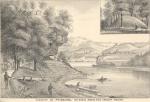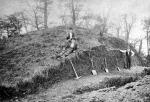![header=[Marker Text] body=[Largest Native American burial mound in Western PA., (16 ft. high and 85 ft wide). It was hand-built by the Adena people between 200BC and 100 AD and later used by the Hopewell and Monongahela people. Late 19th century excavations uncovered thirty-three skeletons and artifacts made of copper and shells.] sign](http://explorepahistory.com/kora/files/1/10/1-A-205-139-ExplorePAHistory-a0h5a3-a_450.jpg)
Mouse over for marker text
Name:
McKees Rocks Mound
Region:
Pittsburgh Region
County:
Allegheny
Marker Location:
Rangers Field, Shingiss and Sproul Streets. The Bottoms, McKees Rocks
Dedication Date:
May 18, 2002
Behind the Marker
Growing up in Charlottesville, Virginia in the mid-1700s, Thomas Jefferson heard an interesting story about an Indian burial mound near his home. Although the local native population had long since been displaced by colonists, one day a party of unknown Indians showed up and, without asking for any assistance, "went through the woods directly" to an ancient burial mound. After spending some time there making "expressions which were construed to be those of sorrow," the Indians, according to Jefferson, returned to the main road, "from which they had detoured about half a dozen miles to pay this visit, and pursued their journey."
Jefferson was fascinated by this story and the clues it offered about the mysterious earthen mounds that dotted the Appalachian frontier. The first reports of their existence came from fur traders traveling through the Pennsylvania and Virginia backcountry. When local Indians were unable to offer any explanation for the mounds' origins, curious European scholars developed elaborate theories to explain their existence.
Some of Jefferson's contemporaries believed that the mounds were created by an ancient civilization in the Americas descended from the ancient Egyptians or Hebrews. Others believed that they were somehow linked to the great Indian civilizations of Mesoamerica, such as the Maya and Aztecs. Still others argued that they were the product of ancient Viking or Welsh migrations to North America. Jefferson suspected that the mounds were the work of the ancestors of contemporary Native Americans, and the story from his childhood of Indians traveling paying their respects at one such mound seemed to confirm his suspicions.
The McKees Rocks Mound, located at the confluence of Chartiers Creek and the Ohio River four miles south of downtown Pittsburgh, is just one of thousands of Indian burial mounds, ranging from a few feet to 100 feet tall, that were still visible in Jefferson's day throughout the Ohio-Mississippi Valley watershed. These mounds took a variety of forms. Most were made out of earth, but some in the south were made out of marine shells. Most were conical in shape, but others had platform, bread loaf, or dome designs. Some were even made in the shape of animals, such as serpents, birds, or deer. The McKees Rock Mound, a dome-shaped earthwork 85 feet in diameter and 266 feet in circumference, is the most impressive example of this ancient Indian architecture in modern Pennsylvania.
Archaeology conducted at the McKees Rocks Mound and similar sites has done much to solve the riddle that fascinated Jefferson. Mounding-building developed among Indians in the Ohio Valley during the Adena culture stage (800 B.C.-100 A.D.) and then flourished during the Hopewell (100-500) and Mississippian Eras (700-1300). The evolution of mound building roughly paralleled the development of maize agriculture in the Ohio and Mississippi Valleys. For the hunter-gatherers of the Adena and early Hopewell periods, the mounds were burial sites that they probably returned to on a seasonal basis. Judging from the log-lined tombs and bountiful grave goods (stone pipes, pottery, jewelry, beads, and tools) found at these sites, burial there signified an elite or honored status.
As the same extended family or lineage returned to the site from one generation to the next, the mound grew larger with the addition of more burials. When the adoption of agriculture made it possible for more settled communities to develop, the mounds became significant as ceremonial and social centers as well as burial sites. This change is evident in the latter Hopewell and Mississippian cultures, when some mounds began to feature ceremonial platforms or adjacent plazas.
By the end of the 1700s, white settlers were moving into the Ohio Valley in large numbers. They destroyed some of the mounds through plowing and road construction; others were lost to amateur archaeologists and treasure-seekers. Some settlers, however, recognized these mounds as ancient and spiritually powerful places and chose to use them as burial sites as well (the excavation of the McKees Rocks Mound uncovered some modern non-Indian burials). Local communities sometimes featured images of these mounds on nineteenth-century postcards.
Popular interest in the mounds peaked during the 1890s, when professional archaeologists excavated many of them. Artifacts recovered from such digs were displayed at the 1893 World Columbian Exposition in Chicago. The following year, a comprehensive study published by the Bureau of American Ethnology gave scientific credence to Jefferson's supposition from a century earlier. The mounds were the work of the ancestors of modern Indians, not an ancient non-Indian civilization.
Archaeologists excavating the McKees Rocks Mound during the 1890s uncovered thirty-three burials, as well as stone and bone tools, marine shell beads, and pottery. The archaeological evidence suggests that this mound was built in three stages by Indians of the late Adena and early Hopewell cultures. Most of the recovered artifacts are associated with the Adena and Hopewell cultures, but archaeologists have also found materials associated with the much later Monongahela culture, which occupied the region during the late Woodland Period (1000-1500 A.D.).
Today, archaeologists do not excavate Indian burials unless such sites are disturbed by some other event, such as a construction project, that will result in their destruction. That professional commitment, along with the protection of many surviving mounds in local, state, and national parks, is helping to preserve this important element of the American past for future generations.
Jefferson was fascinated by this story and the clues it offered about the mysterious earthen mounds that dotted the Appalachian frontier. The first reports of their existence came from fur traders traveling through the Pennsylvania and Virginia backcountry. When local Indians were unable to offer any explanation for the mounds' origins, curious European scholars developed elaborate theories to explain their existence.
Some of Jefferson's contemporaries believed that the mounds were created by an ancient civilization in the Americas descended from the ancient Egyptians or Hebrews. Others believed that they were somehow linked to the great Indian civilizations of Mesoamerica, such as the Maya and Aztecs. Still others argued that they were the product of ancient Viking or Welsh migrations to North America. Jefferson suspected that the mounds were the work of the ancestors of contemporary Native Americans, and the story from his childhood of Indians traveling paying their respects at one such mound seemed to confirm his suspicions.
The McKees Rocks Mound, located at the confluence of Chartiers Creek and the Ohio River four miles south of downtown Pittsburgh, is just one of thousands of Indian burial mounds, ranging from a few feet to 100 feet tall, that were still visible in Jefferson's day throughout the Ohio-Mississippi Valley watershed. These mounds took a variety of forms. Most were made out of earth, but some in the south were made out of marine shells. Most were conical in shape, but others had platform, bread loaf, or dome designs. Some were even made in the shape of animals, such as serpents, birds, or deer. The McKees Rock Mound, a dome-shaped earthwork 85 feet in diameter and 266 feet in circumference, is the most impressive example of this ancient Indian architecture in modern Pennsylvania.
Archaeology conducted at the McKees Rocks Mound and similar sites has done much to solve the riddle that fascinated Jefferson. Mounding-building developed among Indians in the Ohio Valley during the Adena culture stage (800 B.C.-100 A.D.) and then flourished during the Hopewell (100-500) and Mississippian Eras (700-1300). The evolution of mound building roughly paralleled the development of maize agriculture in the Ohio and Mississippi Valleys. For the hunter-gatherers of the Adena and early Hopewell periods, the mounds were burial sites that they probably returned to on a seasonal basis. Judging from the log-lined tombs and bountiful grave goods (stone pipes, pottery, jewelry, beads, and tools) found at these sites, burial there signified an elite or honored status.
As the same extended family or lineage returned to the site from one generation to the next, the mound grew larger with the addition of more burials. When the adoption of agriculture made it possible for more settled communities to develop, the mounds became significant as ceremonial and social centers as well as burial sites. This change is evident in the latter Hopewell and Mississippian cultures, when some mounds began to feature ceremonial platforms or adjacent plazas.
By the end of the 1700s, white settlers were moving into the Ohio Valley in large numbers. They destroyed some of the mounds through plowing and road construction; others were lost to amateur archaeologists and treasure-seekers. Some settlers, however, recognized these mounds as ancient and spiritually powerful places and chose to use them as burial sites as well (the excavation of the McKees Rocks Mound uncovered some modern non-Indian burials). Local communities sometimes featured images of these mounds on nineteenth-century postcards.
Popular interest in the mounds peaked during the 1890s, when professional archaeologists excavated many of them. Artifacts recovered from such digs were displayed at the 1893 World Columbian Exposition in Chicago. The following year, a comprehensive study published by the Bureau of American Ethnology gave scientific credence to Jefferson's supposition from a century earlier. The mounds were the work of the ancestors of modern Indians, not an ancient non-Indian civilization.
Archaeologists excavating the McKees Rocks Mound during the 1890s uncovered thirty-three burials, as well as stone and bone tools, marine shell beads, and pottery. The archaeological evidence suggests that this mound was built in three stages by Indians of the late Adena and early Hopewell cultures. Most of the recovered artifacts are associated with the Adena and Hopewell cultures, but archaeologists have also found materials associated with the much later Monongahela culture, which occupied the region during the late Woodland Period (1000-1500 A.D.).
Today, archaeologists do not excavate Indian burials unless such sites are disturbed by some other event, such as a construction project, that will result in their destruction. That professional commitment, along with the protection of many surviving mounds in local, state, and national parks, is helping to preserve this important element of the American past for future generations.
Beyond the Marker








